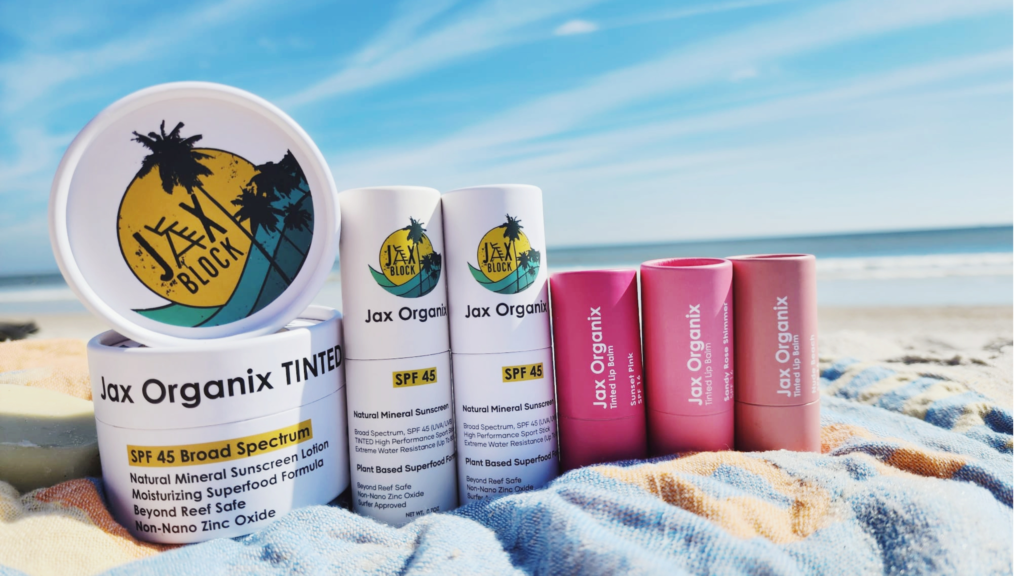Reposting this content from Jax Organix
The Environmental Working Group (EWG) classifies many of the active sunscreen ingredients below as “Toxic and detrimental to coral reef and marine life”. Known to bleach coral, and be toxic to surrounding marine life, imagine what these awful compounds are doing to the skin, on our children, and after biologically compounding in the body after continued use. What about the common inactive ingredients in products that may be reef safe but not human safe?
Many of the top household sunscreen brands were just recently recalled due to extremely toxic levels of benzene, a chemical known to cause cancer. These are are brands that families have trusted for decades.
We don’t have to disguise toxic chemicals and preservatives in a long list of inactive “ok” ingredients. Our Sunscreens are crafted with the perfect combination of 6 organic, food grade inactive ingredients that actually benefit the skin , and the single active ingredient most recommended by the EWG for safe sun protection, non – nano zinc oxide.
We have gone through the expensive and arduous process of testing each of our sunscreen products in vitro through 3rd party laboratories in accordance with necessary FDA regulations to ensure SPF claims, and water resistance claims. The large majority of sunscreen companies have not gone through this process. We also test our products for toxic solvents and heavy metals, almost unknown in the industry. Clean and transparent products that are good for the ocean, and your body is our Beyond Reef Safe promise to you and the planet.
Below is a list of common highly toxic ingredients that are in almost all popular sunscreen brands. They are not reef safe OR human safe, but lack of regulation in cosmetics has allowed companies to cut corners with cheap chemical compounds that sacrifice our health and the health of the ocean for profits.
Oxybenzone
This ingredient was banned in Hawaii because it has been shown to cause harm to coral reefs. Not exactly a ringing endorsement for something to be smeared all over your body. Aside from that, it’s a form of synthetic estrogen, according to the Environmental Working Group, and can cause a disruption in your hormones. The EWG actually considers oxybenzone to be the most troubling sunscreen ingredient.
Octinoxate
Like the aforementioned oxybenzone, octinoxate is also banned in Hawaii for coral reef reasons. It’s been shown to cause skin allergies, and in animal studies, it had effects on the reproductive system and thyroid.
Avobenzone
Often substituted for oxybenzone, banned in Hawaii, but just as detrimental and known to penetrate to skin, incresing risk of cancer. Many companies use it in conjuction with mineral sunblocks and disguise the product as “mineral based” . While this ingredient hasn’t been found to cause hormone disruption like the others, according to the EWG, it causes high rates of irritation. And it’s not sun-stable, which means it has to be mixed with stabilizers, like Octisalate (which the EWG ranks as having moderate toxicity concerns and also banned in Hawaii) in order to be used in sunblock.
Octocrylene
Banned in many European countries,this is a very popular chemical UV blocker in many so called “natural ” sunscreen brands. Known to promote the production of free radicals, which can damage DNA, potentially increasing the risk of melanoma; we suggest you avoid this popular chemical additive like the plague. It was also recently completely banned in the Virgin Islands along with oxybenzone, octinoxate and octocrylene, otherwise known as the “toxic 3 O’s.”
Retinyl Palmitate
This is a form of vitamin A, which is a powerful antioxidant. We’re normally fans of these things – But when retinyl palmitate meets your skin meets the sun, that’s when the problems begin. It is known to actually accelerate skin cancer. Animal studies have shown that, when exposed to the sun, it is potentially cancerous and forms free radicals, which is quite literally the opposite reason you want antioxidants.
Parabens
Parabens are preservatives that prevent the growth of bacteria, yeast, and molds and a large majority of skin care products contain them (estimated 75-85%). Parabens like propyl, methyl or butylparaben can mimic the hormone estrogen which might contribute to breast cancer. Always buy Paraben free products
Phenoxyethanol
Check any store shelf, your personal skin care routine, your mom’s favorite moisturizer. It’s almost guaranteed to have this incredibly toxic preservative in it. This chemical preservative is actually BANNED in most European countries and Japan! Exposure to phenoxyethanol has been linked to reactions ranging from eczema to severe, life-threatening allergic reactions. Infant oral exposure to phenoxyethanol can acutely affect nervous system function.
Fragrances
Found in nearly all chemical sunscreens, many synthetic chemicals in fragrances are petroleum-based and can be harmful to human health. Chemicals found in fragrances include phthalates, which are endocrine disruptors, and carcinogens benzophenone and styrene. In addition, some children and adults have allergic reactions to fragrance chemicals.
Nano-particles
Tiny ingredient particles that are easily absorbed in the skin, and so small they can affect tissue on a cellular level. Many new sunscreen products are advertising “clear zinc” or “nano zinc”. Not enough information is known about the effects of nanos although studies are underway about their safety and how they may adversely affect the body. Be aware of claims like “nano-technology”. Always go for Non-Nano Zinc Oxide and if you’re concerned about looking too white, opt for our lightly tinted version that will subtely blend into the skin leaving a less obvious application.
This Article was provided by Jax Organix


